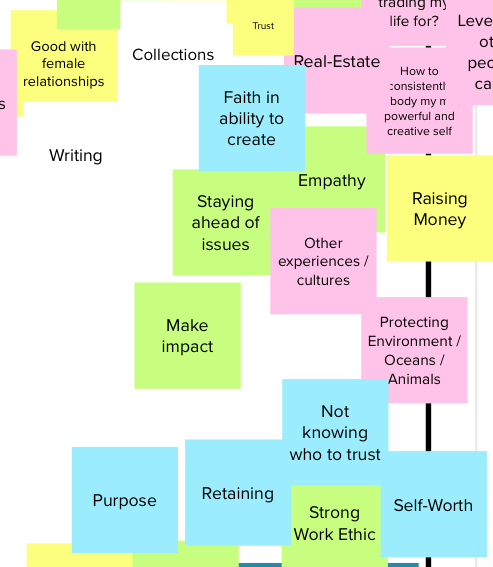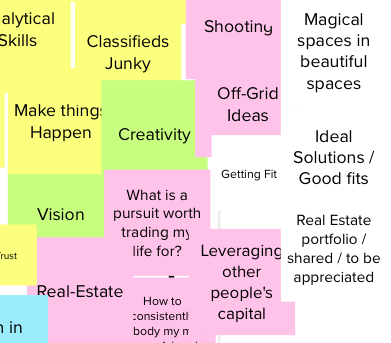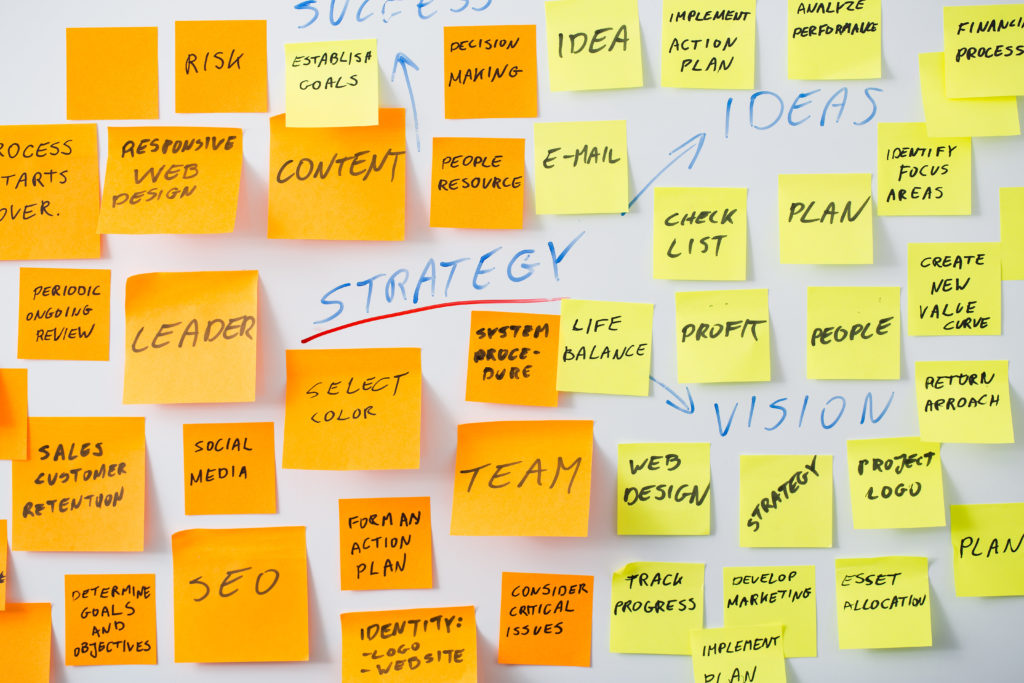Interest Compass
Follow Your Interests, Not Your Passion.
How do you follow a passion if you aren't feeling passionate about a topic? It's bad advice.
Following your interests allows you to explore the areas that give you the most energy and excite you, those are the topics that eventually turn into passions.
This exercise helps move you onto that path.
What option is best for you?
Using Mural
For those comfortable with using software and don't mind working in a digital space.
Analog w/Sticky Notes
This was the original way I did this exercise. It requires a few stacks of Post-It Notes, a marker and ideally a dry erase board or a way to categorize your stickies.
Zoom Guided
Lorem ipsum dolor sit amet, ut duius adipisicing elit, sed do eiusmod nam tempor incididunt ut labore.
Using The Mural Template
In this example we'll do this exercise using the online tool, MURAL. It t does involve some comfort with software and alternate ways of working with documents. It's the tool I use when I need to guide remotely.
MURAL, is a web-based collaboration tool that looks and feels like a office whiteboard.
There is minimal prep needed aside from following my template link and creating an account on MURAL to download the template and start working on it.

Step 1.
Setup a free Mural account
Visit my MURAL template here, and create a free account on MURAL. Once in, you can start using the template. Once in, play with the controls to gain comfort with the tool. Note the stickie notes are on the top left tool bar with the label "Text" when you mouse over the note icon. In the bottom right, you'll see a tool to navigate the template and control your zoom levels.
Step 2.
Fill Out the 6 Categories
Set a timer for yourself, each of these categories should take you no more than 3 minutes. It should feel a bit rushed. That's ok because you can always come back and add more notes. The goal here is to sit with each category and rip off as many notes as you can before moving on to the next category. Below are a few guiding questions to ask yourself along the way.
What are your strengths?
- What do you know in your heart, that you are good at? This may or not be something you do. You could be awesome with building stuff with your hands but you spend most of your time behind a desk building software instead.
What do you avoid?
- This could be anything. Think of the things that pop-up day-to-day that you know you "should do" but don't. Things which you put off or try delegating to others.
- These could also be things you say you want to do, like go to the gym, but you don't do it. List those here.
What have people complemented you on?
- What do you often here from others such as "you are really good at...", "that was amazing", "you know that really well", "can you show me how you...", "you should think about becoming a..."
- When you were a child, what were the things that your were praised for, or that you took pride in?
Where do you struggle?
- We all have our struggles. There are struggles which make us stronger and build our confidence and those which drag us down and deplete us. List both of them here. For me, the good struggle is going for a run, the negative struggle is dealing with emails.
What are you curious about?
- This is my favorite. What are the things that have appeared over your life that make you go "hmm"? (queue C&C Music Factory)
- When reading or watching a video, what topics to you gravitate to. Try not to censor what comes up. Hey, if you fancy yourself a serious engineer and love comic books, awesome!
What do you like to create?
- I believe everyone is a creator. It doesn't matter if it's art, stories, products, food or creating life. We all have something we like to create. List out things you like to create, even if you aren't currently creating them. If you are stuck, find that inner-child, what did they like to create?
Step 3.
Plot the Stickies
Starting at the first category move each sticky over to the grid on the right. The grid is organized from left to right by Weakness to Strength, and vertically from Gives Me Energy to Depletes Me. Move each sticky to where on the grid that topic or attribute feels most appropriate. DO NOT OVERTHINK IT. Go with your instinct, it's right even your mind rejects it.
Step 4.
Note The Clusters
Step back and look at the clustering of stickies. What are some themes that you see in the clusters?
Bottom Left Quadrant: The Energy Suck
These areas you are weak in and deplete you. You might want to take a long hard look at these items and see how you can eliminate them from your life as much as possible.
Top Left Quadrant: Unrealized Potential
These notes are more about untapped areas of your life. You feel higher energy here but maybe not enough confidence to take it further. Maybe you love singing but don't believe you are a strong enough singer to make it a profession. Ask yourself if this really is a weakness of yours or are your simple afraid of what potential you might actually unlock?
Bottom Right Quadrant: Worn Out
In our lives things we do repeatedly can start to exhaust us. This quadrant is home to those categories. Items here are strengths that have been played out. They start to drain you because you've grown enough here, and there isn't a high-energetic vibration to continually staying in this space. Similar to the other lower quadrant, it's time to ask yourself it you need to move on from these items.
Top Right Quadrant: The North Star
Finally, the quadrant we do this exercise for. These items here are the ones that excite you, fire you up and bring life. Look closely at these topics for overlay or hybrid matches on topics that might lead to entirely new journeys. For instance, a colleague of mine had the following clustering.

They took "Magical spaces in beautiful spaces" + "Off-Grid Ideas" + "Real-Estate" + "Leveraging other people's capital" to start down the path of building a sustainable community in a remote portion of Central America. Once he realized that this was a process of discovery and curiosity his energy and optimism rose up, and he began to researching a way forward.
Step 5.
Take Aways
Congrats! You made it through the exercise. What were some of your take aways? Did anything surprise you? Did you have a strong physical reaction to any part of what you did?
If you enjoyed the exercise or have suggestions on how it could be revised, I'd love to hear from you. Hit me at George [at] gmorris.com
Using Sticky Notes
Originally, I did this exercise with Post-It Notes and a white board, and it worked really well. While I thrive in the digital world, I crave the analog, and there is something more satisfying for me to write with a Sharpie and stick it on a wall.
If you don't have access to a white board, that's ok. Below I've provided the instructions for those with or without a whiteboard. However, you will need Post-It Notes! Multicolor ones are the best.

Step 1.
Setup The Environment
This exercise is best using a whiteboard, a large one, like over 5 ft wide. If you have a whiteboard section it off by drawing a line straight down the middle. The left half is for the 6 categories, the right half is for plotting. If you lack a whiteboard, use your wall instead by taping note cards for the categories and the plot graph.
Start by writing out your six categories, either on the whiteboard (spread the categories out evenly on the left), or simply write the categories titles on a notecard or piece of paper. These categories are:
- STRENGTHS
- AVOID
- COMPLEMENTS
- STRUGGLES
- CURIOUS
- CREATE
On the right side of the whiteboard create a plot with the horizontal access on the left labeled "Weakness" on the right side of the access "Strength". Now with the vertical access, label the top "Gives Energy" and the bottom "Depletes Energy." If you don't have a whiteboard simply use notecards and tape them to the wall with in this grid pattern.
Step 2.
Fill Out the 6 Categories
Set a timer for yourself, each of these categories should take you no more than 3 minutes. It should feel a bit rushed. That's ok because you can always come back and add more notes. The goal here is to sit with each category and rip off as many notes as you can before moving on to the next category. Below are a few guiding questions to ask yourself along the way.
What are your strengths?
- What do you know in your heart, that you are good at? This may or not be something you do. You could be awesome with building stuff with your hands but you spend most of your time behind a desk building software instead.
What do you avoid?
- This could be anything. Think of the things that pop-up day-to-day that you know you "should do" but don't. Things which you put off or try delegating to others.
- These could also be things you say you want to do, like go to the gym, but you don't do it. List those here.
What have people complemented you on?
- What do you often here from others such as "you are really good at...", "that was amazing", "you know that really well", "can you show me how you...", "you should think about becoming a..."
- When you were a child, what were the things that your were praised for, or that you took pride in?
Where do you struggle?
- We all have our struggles. There are struggles which make us stronger and build our confidence and those which drag us down and deplete us. List both of them here. For me, the good struggle is going for a run, the negative struggle is dealing with emails.
What are you curious about?
- This is my favorite. What are the things that have appeared over your life that make you go "hmm"? (queue C&C Music Factory)
- When reading or watching a video, what topics to you gravitate to. Try not to censor what comes up. Hey, if you fancy yourself a serious engineer and love comic books, awesome!
What do you like to create?
- I believe everyone is a creator. It doesn't matter if it's art, stories, products, food or creating life. We all have something we like to create. List out things you like to create, even if you aren't currently creating them. If you are stuck, find that inner-child, what did they like to create?
Step 3.
Plot the Stickies
Starting at the first category move each sticky over to the grid on the right. The grid is organized from left to right by Weakness to Strength, and vertically from Gives Me Energy to Depletes Me. Move each sticky to where on the grid that topic or attribute feels most appropriate. DO NOT OVERTHINK IT. Go with your instinct, it's right even your mind rejects it.
Step 4.
Note The Clusters
Step back and look at the clustering of stickies. What are some themes that you see in the clusters?
Bottom Left Quadrant: The Energy Suck
These areas you are weak in and deplete you. You might want to take a long hard look at these items and see how you can eliminate them from your life as much as possible.
Top Left Quadrant: Unrealized Potential
These notes are more about untapped areas of your life. You feel higher energy here but maybe not enough confidence to take it further. Maybe you love singing but don't believe you are a strong enough singer to make it a profession. Ask yourself if this really is a weakness of yours or are your simple afraid of what potential you might actually unlock?
Bottom Right Quadrant: Worn Out
In our lives things we do repeatedly can start to exhaust us. This quadrant is home to those categories. Items here are strengths that have been played out. They start to drain you because you've grown enough here, and there isn't a high-energetic vibration to continually staying in this space. Similar to the other lower quadrant, it's time to ask yourself it you need to move on from these items.
Top Right Quadrant: The North Star
Finally, the quadrant we do this exercise for. These items here are the ones that excite you, fire you up and bring life. Look closely at these topics for overlay or hybrid matches on topics that might lead to entirely new journeys. For instance, a colleague of mine had the following clustering.

They took "Magical spaces in beautiful spaces" + "Off-Grid Ideas" + "Real-Estate" + "Leveraging other people's capital" to start down the path of building a sustainable community in a remote portion of Central America. Once he realized that this was a process of discovery and curiosity his energy and optimism rose up, and he began to researching a way forward.
Step 5.
Take Aways
Congrats! You made it through the exercise. What were some of your take aways? Did anything surprise you? Did you have a strong physical reaction to any part of what you did?
If you enjoyed the exercise or have suggestions on how it could be revised, I'd love to hear from you. Hit me at George [at] gmorris.com
Sign Up for a Guided Session
If you'd like me to coach you through the Interest Compass please sign-up and we'll coordinate a time that works for us both. Sessions usually take 90 to 120 minutes to complete. The session cost is $349.

